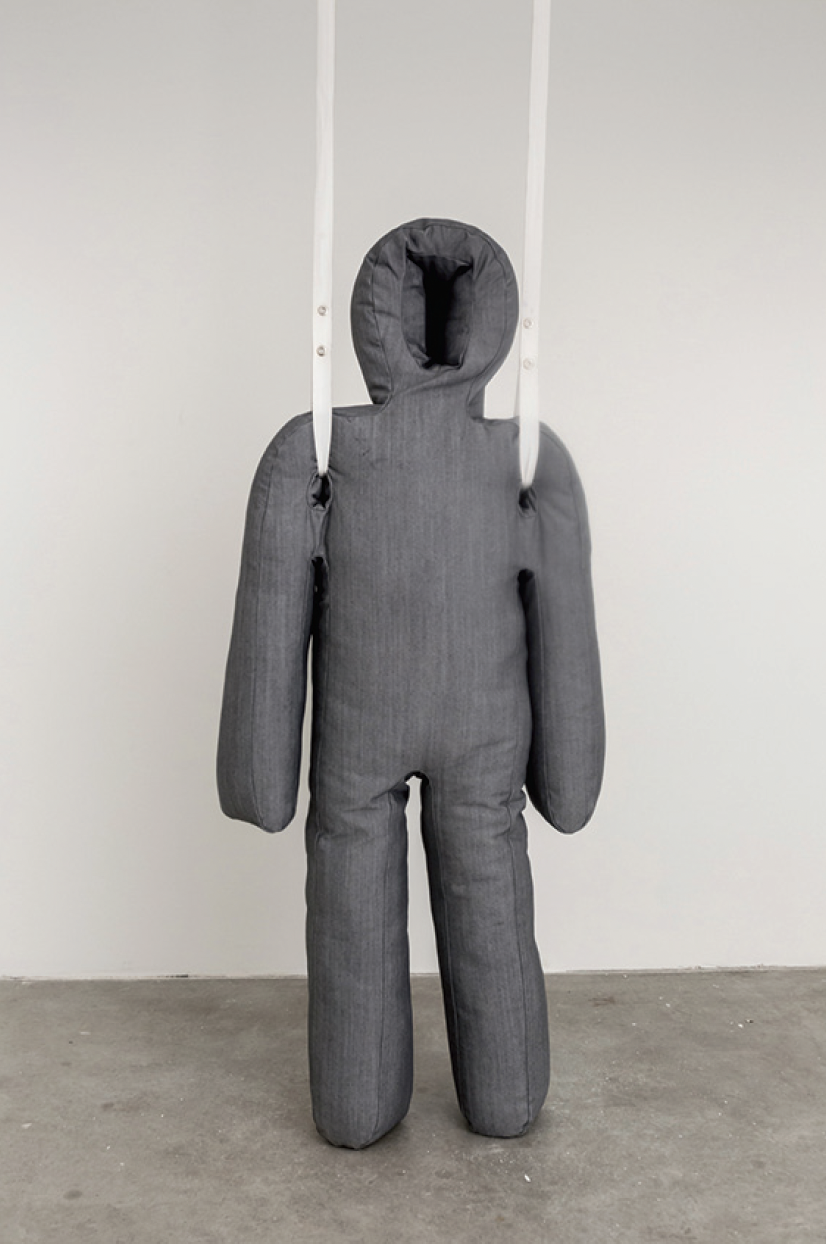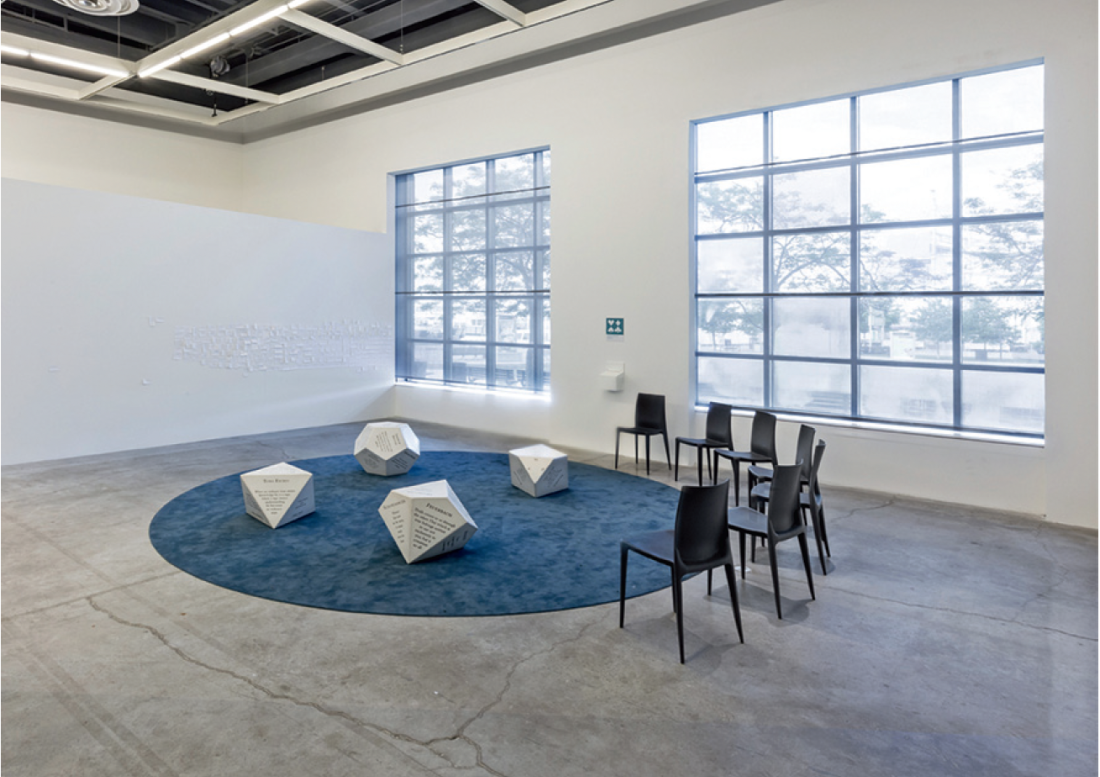Pedro Reyes
As viewers approach Mexican artist Pedro Reyes’s “Sanatorium,” they encounter an official-looking employee donning a white lab coat who asks them to complete an intake form before entering the sectioned-off exhibition. They can then choose up to six therapies in an approximately 30-minute session with an amateur “therapist.”
Reyes claims that the “Sanatorium’s” offering of therapy, if expanded like a franchise, “could result in large-scale social good.” Pop psychology in an art gallery poises itself here to reach the lofty utopianism of Beuys’s social sculpture. However, “Sanatorium’s” volunteer-delivered therapies, which are, in Reyes’s word, placebos, may at best work, to use Nicolas Bourriaud’s term, on a “micro-utopian” scale. That is to say, a few gallery visitors may feel better on exit.
Feel-good techniques requiring a leap of faith are de rigueur. Goodoo, for instance, is a good-witch twist on the malevolent voodoo doll; you affix a charm to an unadorned “goodoo” doll to cast a good luck “spell” on a deserving, special someone. Some charms, like tiny sponges and steel wool balls, are absurdly enigmatic; others, like mini-purses, obviously symbolize what good the wisher wishes upon another.

Pedro Reyes, Installation view, “Sanatorium,” 2014, The Power Plant, Toronto. All Photographs: Toni Hafkenscheid. Images courtesy The Power Plant, Toronto.
Catharsis is another uplifting therapy approach. City Leaks, for instance, involves writing a secret on a piece of paper which is rolled up and placed in a glass bottle. Each participant can, in return, read another person’s bottled secret, leading the piece to act as a two-way confession booth. Offering further emotional release is Vaccine against Violence. People draw the face of someone who hurt them on a balloon affixed atop a punching bag. They can hit or yell at this effigial figure. Before leaving, they take a placebo, in fact a sugar pill, which serves as the “vaccine.” Perhaps this placebo is a metaphor for Reyes’s sundry therapies; they are only curatives if you maintain belief in them.
Accordingly, an aura of religiosity permeates the exhibition, including the oracle-based Philosophical Casino. “Patients” begin by writing down three advice-seeking questions, which are eventually posted on the wall. Next, they roll any of five giant polyhedra dice, whose five sides each bears a quote from a philosopher ranging from Greek to mid-20th century. For instance, Wittgenstein’s pithy statement, “Show the fly the way out of the bottle.” With liberal interpretation from them and their assigned therapist, they may arrive at answers.
Symbolic cure in The Extraction of the Cop in the Head furthers the necessity of faith—faith in transference of group therapy outcomes to those of real life. A group exercise begins with a participant recounting situations where outside pressures oppressed him or her. One speaker, for example, told of how his low self-worth prevented him from leading a fulfilling life. The other group members role-played the oppressors he identified; the therapist encouraged him to challenge them verbally to overcome internal censorship or “the cop in the head.” A scanner and gloves were used ritualistically to symbolize the removal of this “cop.”

Pedro Reyes, Installation view, “Sanatorium,” 2014, The Power Plant, Toronto. All Photographs: Toni Hafkenscheid. Images courtesy The Power Plant, Toronto.
The most effective of these therapies-cum-artworks is The Museum of Hypothetic Lifetimes, a scale model of a hypothetical museum that symbolically visualizes the stages of human life, beginning with the cradle, leading through a labyrinth of rooms whose forms are open to interpretation: a jagged path of rooms can represent teen tumult; another with curved walls can indicate the winding route relationships take. Participants can choose various objects for placement in the museum model—some esoterically comical like a golden turd, others utilitarian, like houses and bridges—to illustrate both past experiences and aspirations. The piece makes the still controversial assertion that within a set of limitations determined by the artist—the model and the objects in this case—the viewer can act, in part, as artist.
The Museum of Hypothetic Lifetimes stands out amongst the six for its specificity to the gallery context. While it is well contextualized, the remainder are displaced in a waterfront-hugging gallery. If Reyes’s intent for the exhibition is indeed “to cure ills associated with urban living,” you are already distanced from such stresses in this setting. The planned therapeutic effect read more explicitly in a 2011 Guggenheim-organized installation of Pedro Reyes’s “transient clinic” installed in a Brooklyn storefront with only a store window between it and the busy streets of New York, the Emerald City of therapists. However, when filling out an out-take form at the Power Plant, designed to gauge anxiety and other negative emotions against those reported on intake, visitors may not have observed any more psychological uplift than they would have when exiting any other gallery exhibitions. Art might already be therapy, as a concurrent exhibition, “Art as Therapy,” at the Art Gallery of Ontario contests, rendering balloon punching and spell casting unnecessary frivolities in performing social good. ❚
“Sanatorium” was exhibited at The Power Plant, Toronto, from June 28 to September 1, 2014.
Earl Miller is an independent art writer and curator residing in Toronto.

